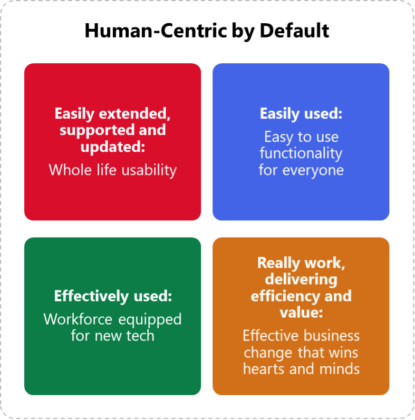
Human-Centric by Default: Why It Matters and What It Means
Anyone who has worked in government—or any large organisation—will have experienced frustration with a new system rollout. The technology itself might be impressive, but it often takes too long to get up to speed, isn’t intuitive, and becomes something you use only because you have to, not because it makes your work easier. Too often, technology implementation forgets the most important element: the humans who use it.
At Hitachi Solutions, we believe technology should serve people—not the other way around. That’s why we take a human-centric by default approach. This means designing solutions with the understanding that humans are complex, emotional, and varied in how they interact with systems and the other people using those systems. It’s not enough to think in terms of ‘users’ or ‘customers’; we need to recognise people as humans, with unique needs, constraints, and responsibilities beyond just their role in a process or department.
Read more about our government strategy here.
Why ‘Human’ and Not ‘User’ or ‘Customer’?
The term ‘user’ is common in technology and design, but it can reduce individuals to only their interactions with a system and none of their personal context and is often commoditised – “How many users did you test with?” ‘Customer’ implies a transactional relationship where the information transition is the focus of the interaction, not the user. ‘Human’ is broader—it acknowledges that people bring emotions, physicality, and unpredictability into their interactions with technology.
For example, research shows that stress impacts cognitive function. When people are overwhelmed, they struggle with long forms, dense text, or unclear processes. By framing design around humans rather than just users, we build solutions that work in real-world contexts—not just in ideal scenarios.
How can you make your process human-centric?
We believe that being Human-Centric involves considering and balancing four different areas of focus.

Easily Used
The first step is to really understand the people involved. This means conducting research to identify who will use the system. It’s important to ask them not only what challenges they face and how technology can make their work easier, but also to gather a picture of how the system will fit into their wider working lives and culture.
Developing user personas—grounded in real behaviours and workflows and highlighting emotions and pressures—ensures that solutions are designed with empathy and relevance. The emotional and cognitive realities of work—stress, multitasking, and decision fatigue—must be considered so that systems don’t just function well technically but also feel intuitive and reassuring to use.
It’s also about designing for humans, not just users. Co-designing with employees and stakeholders helps ensure the technology fits seamlessly into existing workflows rather than disrupting them. Interfaces should be intuitive, reducing cognitive load and frustration. Accessibility must be built in from the outset, ensuring that solutions work for a diverse range of people, including those with different levels of digital confidence or physical abilities.
Deliver Efficiency and Value
Change can often feel overwhelming, so making it manageable and understandable is key to achieving efficiency and value. Clear, jargon-free communication ensures that people understand what’s changing and why to win over hearts and minds. Communication should be a two-way process—giving people a voice, answering their concerns, and adapting where necessary.
Effectively Used
To be truly effective, digital transformation must consider ease of use and adoption to ensure the workforce is equipped with the skills and environment to thrive. Systems should be designed to minimise friction, making it easy for employees to onboard and get up to speed quickly. The processes underpinning the technology should be assessed and optimised for efficiency and ease before a technical solution is applied to them.
Dedicated support—whether through super-users, coaching, or responsive helpdesks—helps people build confidence in new ways of working. Wherever possible, training should fit into existing workflows rather than requiring employees to carve out extra time to learn new systems. Providing hands-on learning, short-form guidance, and ongoing support makes the transition smoother and ensures long-term adoption.
Easily Extended, Supported and Updated
Finally, the most successful transformations balance human and technological needs and consider whole-life usability. Technology needs to evolve over time to better meet the needs of the people using it, so bogging it down with customisation might initially give a great experience but will take its toll over time and will reduce the new shiny system to legacy tech very quickly. Technology should enhance and support human decision-making, not replace it. AI and automation should be used thoughtfully, ensuring that they assist rather than override human judgement.
People: The Realities of Human-Centric Design
We’re talking about human-centric design, so let’s focus on a couple of humans and how it could make their lives easier.
 Alex, the Policy Officer
Alex, the Policy Officer
Alex works in a fast-paced government department, balancing policy development with responding to ministerial requests. A new data platform is introduced to streamline decision-making, but it requires multiple logins, a steep learning curve, and offers insights that don’t always align with real-world policy needs. The result? Alex finds workarounds, avoiding the system where possible, and productivity suffers.
A human-centric approach might:
- Design the system with Alex’s time constraints in mind, offering seamless integration and a simple interface.
- Provide contextual learning resources rather than lengthy, generic training modules.
- Ensure outputs align with the actual needs of policy teams, not just what the system can generate.
 Priya, the Caseworker
Priya, the Caseworker
Priya processes applications for government funding. She deals with a high volume of cases, each with nuanced details. A new case management system promises efficiency but isn’t designed with her workflow in mind. The interface overwhelms her with unnecessary fields, and automated processes don’t account for the complexity of real cases. She ends up doing more manual work just to get around the system.
A human-centric approach might:
- Conduct real-world testing with caseworkers before deployment.
- Optimise automation to assist rather than replace human judgement.
- Offer flexibility so Priya can adjust workflows without breaking the system.
Why ‘By Default’ Matters
“By default” means that something happens automatically as the standard or starting point without requiring extra effort or special consideration. If we are human-centric by default, we automatically try to find the best solution for the people using the system. We might have to make some compromises along the way, but we always pull back towards that human centre to get as close to it as we possibly can. It’s not just a principle we try to include when convenient—it’s our default setting for how we design and implement solutions. We ensure that from day one, our solutions are built around real people, real work environments, and real challenges.
Building Technology for Humans, Not Just Systems
A technically flawless system can still fail if it doesn’t work for the people using it. A human-centric by-default approach means:
- Designing for real-world scenarios—not just ideal workflows.
- Recognising emotional and cognitive factors—stress, fatigue, and multitasking all impact how people interact with systems.
- Balancing user needs with long-term adaptability—so systems evolve with changing demands.
- Creating trust through intuitive design—because when systems work well, people feel confident using them.
At Hitachi Solutions, we don’t just implement technology—we create solutions that work for humans. Because when people thrive, organisations succeed.
That’s what human-centric by default really means.
